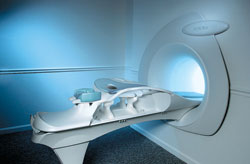 | Info
Sheets |
| | | | | | | | | | | | | | | | | | | | | | | | |
 | Out-
side |
| | | | |
|
| | | | |
Result : Searchterm 'Fat Suppression' found in 2 terms [ ] and 27 definitions [ ] and 27 definitions [ ] ]
| previous 11 - 15 (of 29) nextResult Pages :  [1] [1]  [2 3 4 5 6] [2 3 4 5 6] |  | |  | Searchterm 'Fat Suppression' was also found in the following services: | | | | |
|  |  |
| |
|

From Aurora Imaging Technology, Inc.;
The Aurora┬« 1.5T Dedicated Breast MRI System with Bilateral SpiralRODEO™ is the first and only FDA approved MRI device designed specifically for breast imaging. The Aurora System, which is already in clinical use at a growing number of leading breast care centers in the US, Europe, got in December 2006 also the approval from the State Food and Drug Administration of the People's Republic of China (SFDA).
'Some of the proprietary and distinguishing features of the Aurora System include: 1) an ellipsoid magnetic shim that provides coverage of both breasts, the chest wall and bilateral axillary lymph nodes; 2) a precision gradient coil with the high linearity required for high resolution spiral reconstruction;; 3) a patient-handling table that provides patient comfort and procedural utility; 4) a fully integrated Interventional System for MRI guided biopsy and localization; and 5) the user-friendly AuroraCADÔäó computer-aided image display system designed to improve the accuracy and efficiency of diagnostic interpretations.'
Device Information and Specification
CONFIGURATION
Short bore compact
TE
From 5 ms for RODEO Plus to over 80 ms, 120 ms for T2 sequences
Around 0.02 sec for a 256x256 image, 12.4 sec for a 512 x 512 x 32 multislice set
20 - 36 cm, max. elliptical 36 x 44 cm
POWER REQUIREMENTS
150A/120V-208Y/3 Phase//60 Hz/5 Wire
| |  | | | | | | | | |  Further Reading: Further Reading: | News & More:
|
|
| |
|  | |  |  | |  | |  |  |  |
| |
|
Quick Overview Please note that there are different common names for this artifact.
DESCRIPTION
Black contours at boundaries

Image Guidance
| |  | |
• View the DATABASE results for 'Black Boundary Artifact' (4).
| | | | |  Further Reading: Further Reading: | Basics:
|
|
| |
|  |  | Searchterm 'Fat Suppression' was also found in the following services: | | | | |
|  | |  | |  |  |  |
| |
|
(DE FGRE, Dual/FFE, DE FFE) Simultaneously acquired in and out of phase TE gradient echo images. To quantitatively measure the signal intensity differences between out of phase and in phase images the parameters should be the same except for the TE.
The chemical shift artifact appearing on the out-of-phase image allows for the detection of lipids in the liver or adrenal gland, such as diffuse fatty infiltration, focal fatty infiltration, focal fatty sparing, benign adrenocortical masses and intracellular lipids within a hepatocellar neoplasm, where spin echo and fat suppression techniques are not as sensitive. Specific pathologies that have been reported include liver lipoma, angiomyolipoma, myelolipoma, metastatic liposarcoma, teratocarcinoma, melanoma, haemorrhagic neoplasm and metastatic choriocarcinoma. | | | |  | |
• View the DATABASE results for 'Dual Echo Fast Gradient Echo' (2).
| | | | |  Further Reading: Further Reading: | News & More:
|
|
| |
|  | |  |  |
|  | |
|  | | |
|
| |
 | Look
Ups |
| |